You might remember Al’s post on his Marine Biology Bucket List.
There are so many amazing aquatic species out there, it’s practically impossible for any one person to see them all, even if they dedicated their entire life to marine biology research. To that end, I reckon every good marine bio enthusiast needs a Bucket List of species to strive to see before they die. I’m being really exclusive here – seeing it dead at a market or live in an aquarium counts to the life list. I’ve been lucky enough to see some incredible animals, but here’s the ten species I haven’t seen yet and am determined to before I shuffle off this mortal coil:
Thanks to some great experiences, I’ve crossed some off my list (marked through below). Here is my top ten 14 15 (I keep thinking of more). Unlike Al, I won’t count dead or aquariums encounters. I do count encounters with submersibles and remotely operated vehicles. How do I add species to my bucket list? I use the HS index. Upon encountering a specific animal, I must anticipate that I will declare HOLY SHIT! THAT WAS AWESOME! You may notice a lack of deep-sea creatures on the list. I consider myself lucky that I have seen everything from carnivorous sponges, tripod fish, flytrap anemones, to this rare deep-sea anglerfish (I was on the ROV dive that some of the photos were taken on), and the world’s largest single celled organism. I continue to be awed by both new discovery and encounters with old deep-sea friends. The list below represents species I would not normally encounter in my main research program.
Think I’m missing something? Add your thoughts and your bucket species on the list below
1. Whale shark-Rhincodon typus The largest fish and shark! Yes you will start to note a theme. With my recent excursion to the Afeura to observe the whale shark aggregation, I can cross this one off my list. With Miriam, I had dove with whale sharks at the Georgia Aquarium, a truly amazing experience. However, this did not compare to being in the open ocean, miles from land, snorkeling with dozens of whale sharks. I’ve already pontificated about the really cool science I conducted involving sharks and lasers (no I can’t make this stuff up), but snorkeling along side a 30 foot long male whale shark is beyond words.

2. Giant Isopod-Bathynomus giganteus The largest isopod! My first dive in a submersible, the Sealink, occurred in the Tongue of the Ocean in the Bahamas. During that dive, I saw a Giant Isopod for mere seconds before it quickly swam away. Since then, my contacts have been limited to dead specimens. I count this as siting but I long for more substantial encounter.
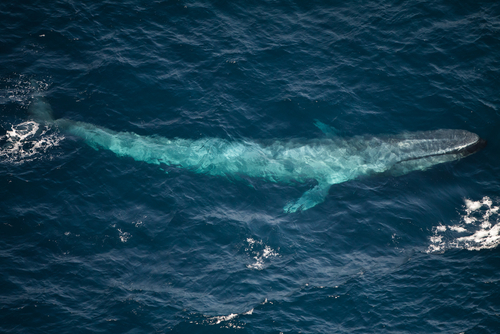
3. Blue Whale-Balaenoptera musculus The largest animal ever to have lived! I think I may have saw one in Monterey Bay from the superb ocean view of my postdoc advisor’s office (so hard to pay attention during our conversations with a view like that), but I can’t be sure. I want to dive or snorkel with this massive beast! I think, and much like it was for whale sharks, you really can’t get a sense for how large an animal until your next to it contemplating your own smallness.
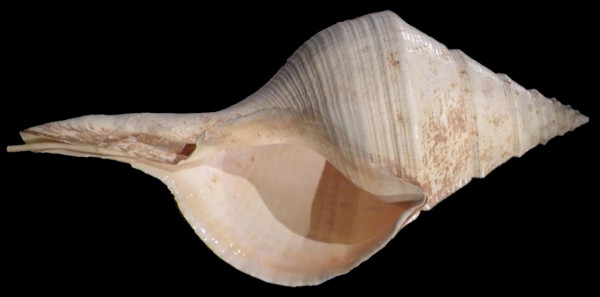
4. Australian Trumpet-Syrinx aruanus The largest snail currently on earth, there were bigger that are now long extinct, can reach lengths of almost 3 feet (~1m) long and a weight of about 40 pounds (18kg)! It occurs along the northern half of Australia toward Indonesia and PNG.
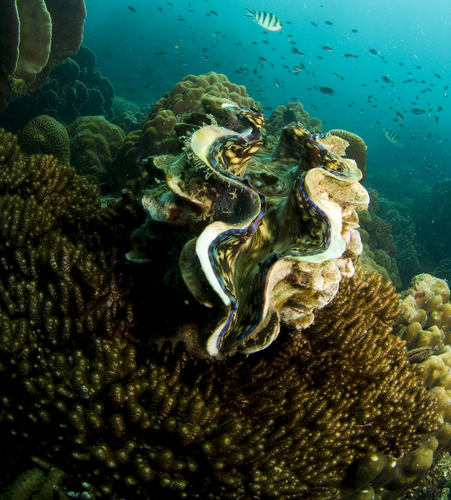
5. Giant Clam-Tridacna gigas The world’s largest bivalve! The largest can reach sizes of over 400 pounds and four feet across! HOLY SHIT THATS BIG! I’ve seen these in aquariums including the fantastic set of them at the California Academy of Sciences (where I someday hope to work, representatives from there can find my contact info at craigmcclain.com). However, these are relatively small at about a foot across. I have also seen shells in museums near their maximum size. But I really, really, really want to see one in the wild.
6. Giant Squid or Colossal Squid-Architeuthis dux or Mesonychoteuthis hamiltoni Speaking of things I want to see in the wild! I have seen multiple specimens of giant squid, including the specimen made famous and stolen in the novel by China Mieville. Unfortunately, I have never seen any part of a colossal squid. However, even thought the chances of this are extremely rare, I say a prayer at the beginning of every ROV or submersible dive that this will be time. Of course, this will one also has the largest HS Index. HOLY SHIT WAS THAT A GIANT SQUID!
7.Lion Mane’s Jellyfish–Cyanea capillata/Cyanea arctica–The world’s largest jellyfish. The bell can reach a diameter of 7 feet and the tentacules can trail over 100 feet. Although they occur throughout the world’s oceans the largest specimens occur closer to the Arctic in colder waters.
So not all my marine bucket list are size record holders and some of them overlap with Al’s.
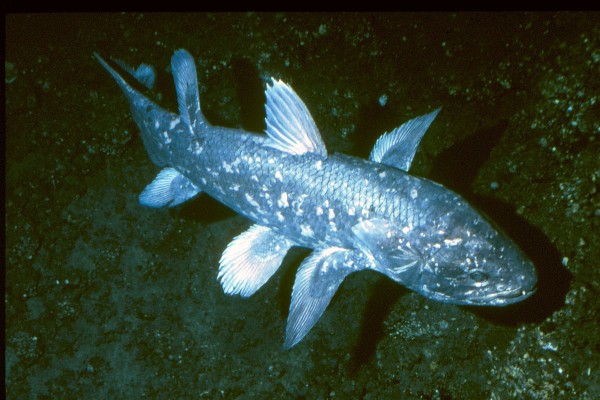 8. Coelacanth-Latimeria spp How could this not be on the list!
8. Coelacanth-Latimeria spp How could this not be on the list!
9. Blue Footed Booby-Sula nebouxii The males do a dance to attract the ladies that includes lifting up their blue feet proudly.
10. Scarlet Ibis–Eudocimus ruber Count this one done! I didn’t even know this should be on my bucket list until I saw them roost in Trindad in person. The brilliant scarlet coloration is breadth taking and leaves one in awe of its intensity. Massive flocks gather in wetlands like the Caroni Swamp of Trinidad.
 11. Leafy sea dragon – Phycodurus equus. To date, I’ve only seen them in aquariums. Some scuba diving and trip to New Zealand/Australia in December (as part of the Deep-Sea Biology Symposium) will remedy this!
11. Leafy sea dragon – Phycodurus equus. To date, I’ve only seen them in aquariums. Some scuba diving and trip to New Zealand/Australia in December (as part of the Deep-Sea Biology Symposium) will remedy this!
And like Al I have to include
12. Garden eels –Heteroconger, Gorgasia, Taenioconger
13. Christmas Island red crab – Geocarcoidea natalis
14. Flying squid – Todarodes pacificus
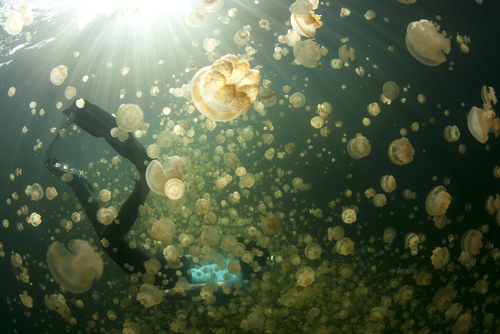
15 And last the Mastigas sp and Aurelia sp of Jellyfish Lake in Palau. I would snorkel among 1.000’s of jellyfish in these lakes and proclaim HOLY SHIT THAT’S A LOT OF JELLYFISH

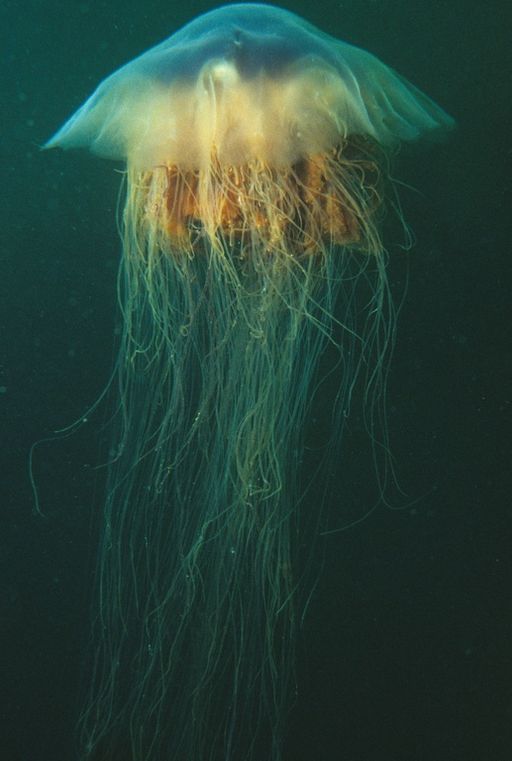
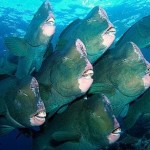



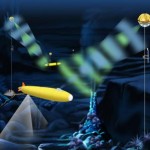
What do you think about expanding the marine bio bucket lists to a version that’s more accessible to the general enthusiast? Both this and Al’s list are really mostly attainable by super badass researchers such as yourselves. Which just makes the rest of us envious :)
An 100-item list with some low-hanging fruits (high-intertidal shellfish?) might make a fun blogpost for folks to share.
Ex:
– Get cleaned by a cleaner goby/wrasse
– Shake out a Sargassum bunch to look for critters
– Grunion spawning
– Salmon migration
I think I’ll add a giant pyrosome to my previous list.
Nice! Glad to know that ‘jellyfish lake’ made it on your bucket list. And when you get the chance to visit, you can check out the giant clams as well. You can actually do both in a single day.
My wife got cleaned by a cleaner wrasse when we were snorkelling off Malaysia.
Her: “What was that?”
Me: “A cleaner wrasse.”
Her: “What does it do?”
Me: “It picks parasites and skin flakes off larger animals.”
Her: “I DO NOT have parasites.”
MANTIS SHRIMP MANTIS SHRIMP MANTIS SHRIMP MANTIS SHRIMP MANTIS SHRIMP MANTIS SHRIMP MANTIS SHRIMP MANTIS SHRIMP MANTIS SHRIMP MANTIS SHRIMP MANTIS SHRIMP MANTIS SHRIMP MANTIS SHRIMP MANTIS SHRIMP MANTIS SHRIMP MANTIS SHRIMP MANTIS SHRIMP MANTIS SHRIMP
Also: Humboldt squid (from inside a tank); leopard seal; mimic octopus; Steller’s sea eagle; goblin shark; seven-gilled shark; torpedo ray; giant cuttlefish.
In the meantime, I will console myself with having got blue whale, and blue-footed booby from Craig’s list. And weedy sea-dragon – close enough.
this is incredible. You had things on your list I did not even know existed. I think I shall do like you with the Scarlet Ibis (wow–I never knew!) and go out with a bucket and put things in as I go.
Blue whale: yes, I would love to be in the water when one is nearby. Not too close though.
lolz.
These images are awesome. Some this these creatures are really creepy. I’m assuming that jelly fish is lethal?
I believe Ed Yong missed one more Mantis Shrimp. Also toss Nudebranch and Christmas Tree Sea Worms in your bucket.
Hi Craig,
Our lists overlap a lot, not surprising given our common interests, and you will win on most, although I do have both jellyfish lakes, and big Cyanea (holy snarkles, this was in Prince William Sound diving and this critter was HS big – he says with the memory of the testicles in the throat feeling when realizing why all those tentacles were around him), as well as – 30 some years ago, now – a Tridacna gigas in Palau that – I will swear – was as long as I was.
My all time bucket list animal, though, – which I am fortunate to have seen – from the JSL II in the Bahamas – Stalked crinoids, and then when, back on shore, and a couple beers and one can take a true mental trip to the Ordovician.
The Lions mane is venomous but the one in Jellyfish Lake in Palau won’t do you much harm
Dr. McClain,
I have a quick question related to your earlier article, “Making The Connection: The Oceans In Contemporary American Culture”. I am currently working on a project about how the ocean and marine life inspire us creatively. I would like to find examples that are very well-known pieces of art from any medium, new or old, that my audience will quickly recognize. Also, I would like to find pieces that were influenced by the ocean but most people might not even realize it, such as the shape of any kind of architecture.
Any help would be greatly appreciated! Thank you!
Dr. McClain,
I have a quick question for you. I am currently working on a project in which I have to give examples of common household products that utilize elements from the ocean. Currently, the majority of my research focuses on algae and its use in coloring, gelling and stabilizing products. I was wondering if you might have any other suggestions for ocean resources in common, everyday, products.
Any suggestions would be greatly appreciated. Thank you for your time.
Love this idea!
What about Winslow Homer’s The Gulf Stream http://en.wikipedia.org/wiki/The_Gulf_Stream_(painting)
There is also Van Gough’s Seascape at St Maurice http://www.vangoghgallery.com/catalog/Painting/480/Seascape-at-Saintes-Maries.html
Of course there is also anything by Hokusai http://www.enchantedlearning.com/artists/hokusai/
Architecture…I’m not sure. Maybe the readers know?
You have the ones I can think. Maybe the readers or other bloggers here at DSN might have answers?
Thanks so much for the suggestions, Dr. McClain!
These will help a ton!
Many of these species, are in fact accessible to the general public, though you’ll need a passport to see most of them. As a recreational diver who goes on one dive trip per year, I’ve seen:
Whale sharks in Mexico
Giant clams in Tanzania
Garden eels in tanzani
Lions mane jellyfish in Vancouver
Mantua shrimp in Malaysia
That’s last one was Mantis shrimp.